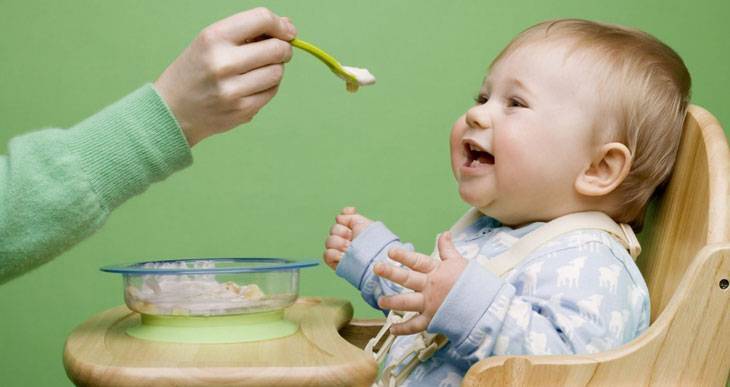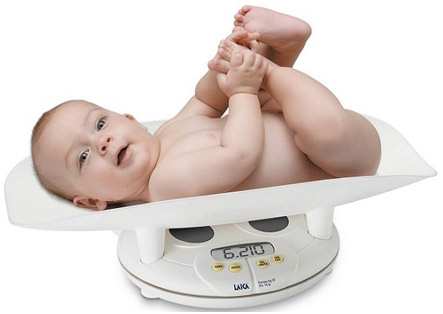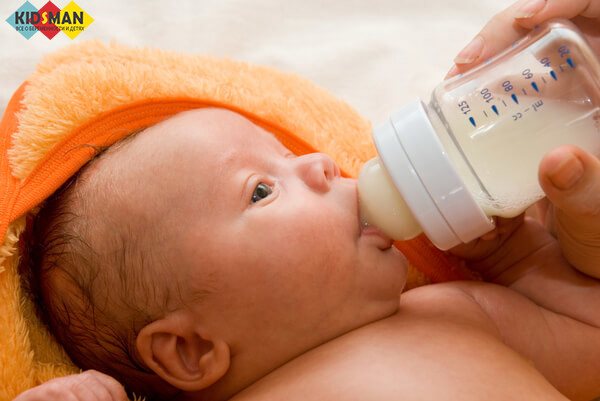It doesn’t matter at all whether the baby is breastfed or eats formula - the woman will not stop worrying about having enough food and feeding rates. For each of the options, there are secrets to how much a newborn should eat. Let's consider the standard indicators of a newborn's diet.
Feeding a newborn baby is one of the most exciting issues for young parents, because the development and growth of the child depends on this.
How much should a newborn eat?
What to do if a child eats little at 1 month?
Many parents judge the state of health by the baby's appetite.
If the baby eats less than normal, mothers begin to worry. To understand whether to sound the alarm, you need to find out the reason why the child is not eating enough. They can be physiological, due to the individual characteristics of the body, and pathological, caused by the disease. The first group of factors for poor appetite includes:
- the mother’s nipples are too hard (if the baby is breastfed) or an unsuitable nipple (for artificial babies);
- the child does not like the taste of food. If he feeds on mother's milk, this may be due to the woman's non-compliance with the diet. For example, onions, garlic, and various spices spoil the taste of milk. Some mixtures may not suit the baby;
- child's passivity. The lower the baby's activity, the less energy he spends. Therefore, a small portion of food is enough for him to replenish his energy;
- slow metabolism. In this case, food takes a long time to digest.
If a child is cheerful, gains weight normally, and has a restful sleep, this means that satiation with a small amount of food is due to the characteristics of his body and is a variant of the norm. Moodiness, weight loss, troubled sleep, lethargy indicate that the baby is not in good health.
Pathological reasons for a child not eating enough can be:
- gastritis;
- diabetes;
- pancreatitis;
- infectious viral pathologies (influenza, ARVI, rubella);
- colic;
- stress;
- allergy;
- stomatitis;
- poisoning;
- cold;
- disruptions in the gastrointestinal tract.
In addition to poor appetite, there will also be signs of illness. These include: fever, loose stools, vomiting, rash. The reason that a baby is not eating enough can be determined by a pediatrician. Most often, one-month-old babies do not eat well due to paroxysmal abdominal pain due to increased gas production.
Colic torments babies up to 3-4 months. To help a child, pediatricians recommend massage. If poor appetite is due to pathology, then you need to visit a pediatrician, undergo examination and treatment. You should not give your baby any medications on your own.

If the mother's nipples are too hard and it is difficult for the baby to suck out milk, then you need to supplement him with bottle feeding. If the baby is passive, then it is worth increasing his physical activity.
It is recommended to massage him, do gymnastics, and play more. This is beneficial for all children for normal growth and development. Walking in the fresh air also increases your appetite.
If food consumption is less than normal due to the fact that the baby does not like breast milk, then the woman needs to make adjustments to her diet. If the adapted mixture tastes bad, then it is worth replacing it.
How can you tell if your child is full?
Every mother knows the signs that the child is full and feels well:
- the baby behaves calmly;
- sleeps soundly;
- recovers according to the established schedule;
- pees and defecates regularly.
The most important thing is to be attentive to your child, watch and be patient - your baby knows exactly how much he wants to eat and when. Over time, sleeping and feeding patterns will improve on their own as they grow older. Do not forget about the individuality of each baby - do not overfeed him or worry about trifles.
How much milk does a newborn need during breastfeeding?
Today, the approach to breastfeeding has changed dramatically when compared with the recommendations of pediatricians twenty to thirty years ago. Increasingly, women are turning to breastfeeding consultants who tell young mothers in detail about the rules of feeding a baby, the technique of breastfeeding and other nuances.
Now it is important to maintain close contact with the baby, so feeding on demand is encouraged
In the maternity hospital, a young mother is explained the rules for attaching a child to the breast in order to establish breastfeeding from the first days
What if he doesn’t have enough: secrets of the first feeding
But mothers most often worry in the first days after the birth of a child, when there is no milk as such yet, and the body produces only colostrum. Moreover, the amount of this valuable nutrition for the baby is very small: during the first breastfeeding, the baby receives about 1.5–2 ml of colostrum.
When colostrum enters the baby’s body, it is completely absorbed, because it contains practically no fat and provides the child with passive immunity, which protects the baby from many infectious diseases. After the next meal, the amount of colostrum increases slightly and reaches 200–300 ml per day. During one feeding, the baby eats about 20–30 ml of liquid on the second and third days after birth.
Newborn babies eat only colostrum for the first days, and that’s enough for them
However, many women are worried that colostrum alone is not enough for the baby and he is not getting enough. You can often hear the opinion that in the first days the child needs to be supplemented with formula. This is a false statement: the amount of colostrum is absolutely sufficient to meet all the nutritional needs of an infant. Therefore, women should not worry about this.
Therefore, experts insist: for a child in the first days of life, the nutrition he receives during breastfeeding is quite enough. It is also worth noting that the volume of a newborn baby’s stomach is very small and is about 10 ml. Therefore, 7–8 ml of colostrum eaten at one feeding on the first day is quite enough for the baby.
Required milk standards in the first ten days of a baby’s life
The baby feeds on colostrum for the first two to four days after birth. He is actively mastering the sucking reflex, which is not yet very developed, and is learning to properly grasp his mother’s breast in order to extract valuable liquid. The volume of the stomach increases every day, so the child begins to eat more milk. The baby is put to the breast about 8-10 times a day.
In the first days after birth, the baby is often put to the breast: on average, 8–10 times
There is a formula that makes it easy to determine the amount of milk consumed for a child in the first days of life. It looks like this: N*10=the amount of milk that the baby should eat in one feeding, where N is the number of days from the moment the baby is born.
Table: How much milk does a baby eat in the first ten days after birth?
Sometimes doctors determine how much milk the baby has eaten by weighing the child. It is necessary to weigh the baby before feeding and immediately after. The difference in weight shows how much liquid entered the baby’s body during feeding. Sometimes women worry because... By the time they are discharged from the maternity hospital, children lose weight. Doctors rush to reassure that this is a normal phenomenon: after birth, the child’s body is cleansed, excess fluid leaves, so his weight decreases. This does not mean that the baby does not have enough milk.
What is important to consider
At first, mother and baby are just getting used to the changes taking place, so the feeding regimen may not be ideal. However, you should adhere to the following rules.
In the first couple of weeks, a lot of dedication is required from the woman, because the interests of the child in satisfying hunger come to the fore. You cannot deny your baby food, even if it costs a sleepless night. If there is any doubt that the child is undernourished or overfed, it is better to start monitoring the frequency of feedings. So, you need to note the time at which the baby was really hungry, and note the intervals between feedings. This information may also be useful at an appointment with a pediatrician. It is impossible to establish a clear feeding regimen, as with artificial feeding, especially in the first weeks after birth. It is highly not recommended to maintain intervals of more than 2–3 hours during the day and 3–4 hours at night. There is no need to try to force feed your baby. He is still too young to realize the need for food, and is guided solely by his feeling of hunger. If your child persistently refuses to breastfeed, you should try offering him something to eat a little later. If the interval is too long, it is better to consult a specialist for advice.
It is important to ensure that your baby latch onto the breast correctly. His mouth should capture not only the nipple, but also the areola
This way, milk will flow correctly into the mouth, and the woman will reduce the risk of cracked nipples. It is not recommended to give pacifiers and bottles to breastfed babies. Such products can reduce the intensity of sucking movements. It is better to give the baby only one breast at one feeding. In the mammary gland, foremilk is formed, with which the baby quenches his thirst, and hindmilk, with which he “gets enough”, since it is more nutritious in composition. After each feeding, you need to hold the baby in a column for about 10 minutes. This helps free the tummy from air and excess milk.
As a rule, with a normal feeding regimen and a sufficient amount of milk from the mother, by the month the baby’s weight increases by 500–600 g.

Features of feeding in the first days after birth
The long-awaited baby has finally been born, and although the parents have not yet had time to completely adapt to the new regime, they are already trying to make his life as comfortable as possible. Since in the first days after birth, requests are limited to sound sleep and a full stomach, mothers try to satisfy their needs to the fullest. As a rule, an infant expresses any dissatisfaction in the only accessible way - by crying. Parents perceive this as a signal of a lack of food. In fact, according to experts, hunger may be the least likely reason for babies to cry.
The baby's body adapts to life from the very first days. The stomach begins to rapidly increase. Therefore, the amount of food consumed is growing every day.
The amount of milk produced directly depends on the frequency of breastfeeding
In the first month of life after birth, when lactation is just establishing, it is very important to give the baby breastfeeding on demand, even if this happens often. The baby does not yet have the strength to overeat, but he will be able to “pump” the amount of milk he needs
For the same reason, experts believe that early breastfeeding immediately after birth is necessary.
The baby does not yet have the strength to overeat, but he will be able to “pump” the amount of milk he needs. For the same reason, experts believe that early breastfeeding immediately after birth is necessary.
There is no clear and rigid norm for milk consumption established for everyone in the first days of a child’s life. In fact, the physiological needs of babies vary as much as any of their individual characteristics. The same applies to breast milk, the nutritional value of which is determined by the characteristics of the woman’s body.
At first, it is advisable for the baby to eat all the milk. The milk remaining in the breast signals the body that such quantities are not in demand. If the baby is full, but there is still milk, then it is better to express it. At first, feed the baby with only one breast so that the other has time to accumulate milk.
The amount of food a newborn consumes will depend on various factors. Nature prepares babies for the only acceptable nutrition in the womb. The sucking skill is inherent in every baby, but the degree of manifestation will vary depending on the child’s well-being or appetite. Sometimes physiological discrepancies, such as between the baby's mouth and the mother's breast, prevent adequate nutrition.
Many mothers are concerned about the fact that in the first days after birth the baby stops sucking too quickly. In fact, the child quickly fills up with colostrum, which is produced in the first days and which is much fattier and more nutritious.
The volume of food consumed directly depends on the volume of the baby’s stomach. A one-month-old baby has a stomach volume of no more than 10 ml. As the stomach enlarges, the baby's appetite will also increase. If in the first days the baby eats up a teaspoon of colostrum, then after a day he will need to drink 10 grams. By the time milk appears, the baby will eat up to 50 ml. On the fourteenth day after birth, the baby approaches 100 ml of nutrition.
Conditions for introducing complementary foods
Regardless of what feeding the baby is on, the procedure for introducing subsidies is identical
It is important to observe the following rules:
- if purees introduced into the diet are prepared at home, all fruits are subject to heat treatment;
- fruits and vegetables are thoroughly chopped so that the baby’s stomach can easily digest the dish;
- despite the fact that complementary foods are semi-liquid in consistency, they must be given to the child from a spoon;
- a new product is introduced into the subsidy after the child gets used to the previous one;

Accustoming to a new dish
- they begin to give puree once a day in the first half of the day, gradually increasing complementary feeding to 3 times;
- For better absorption of new food, subsidized portions are diluted with a few drops of breast or adapted milk.
Note! During feeding, the baby is given a subsidy before the main course. Otherwise, a toddler who is full of milk may refuse complementary foods (with the exception of drinks)
If the baby is breastfed
Complementary feeding is a denser food for the stomach than breast milk. Therefore, the baby will be thirsty throughout the day. It is better to quench it not with water, but with fruit drinks, rosehip decoction or weak tea.
Artificial baby
For children fed exclusively on formula milk, complementary foods begin to be introduced 2-3 weeks earlier. Therefore, at 5 months, the baby’s diet is supplemented with cottage cheese. Vegetable puree and water porridge are flavored with a small amount of vegetable oil. You can give the artificial one a little scraped apple at one of the feedings.
There is also a difference in the composition of the diet. In infants from 4 to 5 months, lunch feeding is completely replaced by a subsidy, and from 5 months, mother's milk is given only 3 times a day. For bottle-fed babies, the adapted formula is left at every meal.
How much milk does a newborn need?
After birth, mother and child form a new bond - breastfeeding. Breast milk contains all the vitamins and microelements a little person needs, so obstetricians advise not to give it up.
In the first days, the newborn baby will eat little. The small amount of milk consumed depends on several factors:
- high fat content of mother's first milk (colostrum);
- baby's small stomach;
- poorly developed sucking reflex.
In the first days, 7–9 ml of colostrum is enough for a baby to be full and not exhausted (suckling at the breast is hard work for such a baby). The daily norm is about 100 ml. It turns out that the mother should latch on to the newborn 10–12 times a day. It often happens that the child literally “hangs” on the mother without interruption. There is no need to take his breasts away from him, because this is not only a way for the baby to get enough, but also an opportunity to feel his mother nearby.
Secrets of the first feeding
With each generation of mothers, doctors' views on breastfeeding change. Today, pediatricians say that there is nothing better than mother's milk. Even colostrum, which was expressed literally 50 years ago, is considered the healthiest food for a newborn. To make the first feedings a joy for mother and baby, you need to know little secrets:
- Immediately after birth, the baby should be put to the breast.
Obstetricians will advise and help you on how to do this. At this moment, the mother meets her son or daughter. The child feels calm, and milk production begins to actively occur in the woman’s body.

- The duration of the first feeding should not be less than 15 minutes.
The figure is, of course, approximate. Even if the mother has not yet produced colostrum, the baby still needs to be attached to the breast to establish the sucking reflex.
- Colostrum contains the maximum amount of nutrients.
From this moment on, the mother can be calm, since her child has received protection. The first portions of mother's milk contain antibodies, immunoglobulins and other elements that help the baby fight harmful viruses and microbes.
Milk standards in the first ten days
After 3–4 days, the woman produces full milk. Sometimes this change is accompanied by an increase in body temperature and active discharge from the nipples in between feedings. You need to be patient a little for everything to return to normal.

The child’s appetite also increases and he begins to actively gain weight. The amount of milk eaten at one time is 20–50 ml. Every day the portion will increase. In one week, the baby will suck up to 80 ml at a time, while the daily dose will be 400 ml. At two weeks from birth, the baby should consume up to 15% of its weight.
When and how best to feed your baby
Even 30 years ago, pediatricians strictly ordered feeding a child by the hour. It is impossible to explain to a one-month-old baby what a schedule is. The baby can eat more than normal at one time, and then sleep through the next feeding for 30 minutes. Today, doctors have abandoned this practice, declaring that a baby can and should be put to the breast when he asks, regardless of the time of day.
This approach to nutrition has its advantages:
- The mother is calm because the child does not cry from hunger.
- The baby is calm, because at any moment he can feel his mother nearby and eat.
- Frequent breastfeeding helps to produce the required amount of milk.
If the child wants to eat while walking, then you need to take a bottle of expressed milk with you or find a secluded corner. Many entertainment centers and parks have special feeding areas.
At night, many mothers prefer to take their baby to bed with them to feed them without waking up. In this case, it is better to place the crib close to the mother's bed, removing one side.
Nutritional standards for up to one year
The table will help you visually find out how much milk a child needs up to one year:
| Child's age | Milk volume per feeding, ml | Daily milk intake, ml |
| 3 days | 20–50 | 200–300 |
| 1 Week | 60–80 | 400 |
| 1 month | 100–110 | 600 |
| 2 months | 110–150 | 800 |
| 3 months | 150–180 | 15% of the child's weight |
| 6 months | 210–240 | 14 % -“- |
| From 0.5 to 1 year | 210–250 | 12 % -“- |
Table of nutritional norms for up to a year
Until one year of age, children should receive the same amount of food. To determine the optimal amount of milk for a child, a special table has been created that outlines nutritional norms depending on age:
| How old is the baby? | Amount of milk per single meal in milliliters | Daily indicator |
| Three to four days | Up to 60 | No more than three hundred milliliters |
| Up to one week | Up to 60 | No more than four hundred milliliters |
| Up to two weeks | Up to 90 | 20% of the newborn's weight |
| Up to 1 month | Up to 110 | No more than six hundred milliliters |
| At 2 months | Up to 150 | No more than eight hundred milliliters |
| At 3 months | Up to 180 | 16.5% of baby's weight |
| At 4 months | Up to 210 | 16.5% of baby's weight |
| At 5 - 6 months | Up to 240 | 14.2% of the baby's weight |
| From 7 months to a year | Up to 240 | From 11% to 12.5% of the child's weight |
Many people try to calculate how many grams of breast milk a newborn should eat. This indicator is easier to calculate in milliliters, since the feeding substance is liquid.
After reaching six months of age, the baby’s diet must be diversified, accustoming him to other foods.
This should be done sequentially, as indicated in the table:
| Age | Products |
| From six months | Vegetables |
| From 7 months | Buckwheat, oatmeal, corn porridge, vegetable and butter |
| From 8 months | Puree with fruits and meat, yolk |
| From 9 months | By-products, fermented milk products, cookies for children |
| From 10 months | Fish, juices based on fruits, berries and vegetables |
| From year | Berry puree, meat broth |
The first porridges should be cooked entirely in water. It is not recommended to add vegetable oil before the age of seven months. For the first time, just one drop will be enough. Each time the volume needs to be increased until it reaches one teaspoon. The situation is similar with butter. Starting from one gram, the portion should be gradually increased to ten grams.
How much should a baby eat at 1 month?
The standards of pediatricians of the last century prescribed that by the age of one month a baby must absorb up to 900 grams of mother's milk or formula. Given the different weights at which a baby is born, all newborns have their own nutritional needs.
Unfortunately, not all babies are breastfed. Many people are forced to eat formula from the first days of life. Some newborns have a mixed feeding pattern. Therefore, knowing the rules of feeding is the main problem of parents, how to calculate the optimal amount of food for each feeding. The determining factors for calculation are body weight and age in days.
In the first days of his life, a newborn eats a small portion. The stomach is so small that it is not able to absorb more than 20 ml of food. But by the tenth day, the growing body is able to absorb more food. The stomach is growing, and a newborn can easily eat 80-90 ml per feeding.
Important! If the baby is breastfed, he does not need additional water. He satisfies all his fluid needs with his mother's milk.
If he wants to eat or drink, the breast is enough for him.
Ready-made formulas are very different in composition from breastfeeding. The baby needs some water. Pediatricians recommend the amount of water per day - the volume of one feeding. If the baby has gained weight of about 3800 grams by the month of life, he needs up to 100 ml of additional liquid per day to the milk formula.

Child drinks water
If the infant is mixed-fed: how much formula to give?
There are babies who are fed a combination of mother’s milk and an adapted formula. If weight gain is poor, your doctor may recommend bottle feeding your baby. The main thing is not to overfeed your newborn.
In order not to make a mistake with the amount of food for a little person, consult a pediatrician. The most effective option is to conduct the so-called “wet diaper test” - the less the child goes to the toilet, the less milk he gets.

At first, you will feed your baby on demand if you are breastfeeding.
For example, at 5 months a baby needs to pee about 12 times, and if this amount is less, you need to additionally feed him 100 ml of formula. From the first days of life until 6 months, mother's milk is the only necessary food for babies. Not only parents, but also a doctor monitor the correct regimen and weight gain.
If it seems that the mother’s milk is not enough, it is recommended to first consult with a pediatrician. An extreme case is to supplement the newborn with formula. However, experts recommend not to interrupt breastfeeding under any circumstances: this is the best and most necessary nutrition for your miracle.
Features of the feeding process in the first days
Immediately after the baby is born, it is placed on the mother's breast to learn the act of sucking. For the first three days, colostrum is produced instead of milk. It is very nutritious, there is little of it, but this amount is quite enough for a small stomach. Just 1 teaspoon - and the baby will be full.

On the second day, the baby's need for food increases, he eats more and begins to ask for milk more often, after about three hours. How much does he eat at this time? During one feeding, the baby eats about 20 grams. A newborn should receive approximately 90 grams of colostrum per day. He eats about 10 times a day, or even more.
By the third day, the child becomes more accustomed to the new living conditions, and his sucking technique improves. There is more milk. Lactation improves with each breastfeeding. During one feeding he can eat about 30 grams. During the day, the child eats approximately 170 ml of milk.
How much mother's milk should a baby suck at 7 days? By the end of the week of life, he eats 60 grams per feeding. This will be 400 ml per day. At two weeks, the baby already eats about 500 ml of breast milk.
The rate of consumption of the required amount of food for a child in the first ten days can be calculated as follows: multiply the number of days of life by the number 10. For example, a newborn at the age of 6 days drinks approximately 60 g.

There is another way to determine it - expressing milk before feeding. By pouring milk into a bottle, you can see the volume of food. You just need to take into account that the baby manages to suck 20–30 grams more.
Experts say that there is no need to force-feed a child for one month or establish a strict schedule by the hour, especially if he is breastfed. It is necessary that the child himself asks to eat. At the same time, he will begin to cry, and when he brings the bent little finger to his mouth, he will turn his head and suck it.
How long does one feeding last? The duration of a 1 month old baby's stay at the breast can range from 15 to 40 minutes. You should not leave your baby near your breast for a longer period of time.
Features of nutrition during artificial feeding
Sometimes the baby may consume less formula than he should. This is par for the course. Usually the deficiency is corrected at the next feeding. It should be taken into account that in the digestive system of a baby, formula is processed somewhat more slowly, so breaks between meals during the day can reach three hours, and at night it is better to wait up to 6 hours.
The main thing, after finishing feeding, is to help the baby burp the air swallowed during the meal. If the baby has not eaten the prepared mixture completely, then you can supplement it after a certain period of time.
How much milk does a newborn need during breastfeeding?
Today, the approach to breastfeeding has changed dramatically when compared with the recommendations of pediatricians twenty to thirty years ago. Increasingly, women are turning to breastfeeding consultants who tell young mothers in detail about the rules of feeding a baby, the technique of breastfeeding and other nuances.
Now it is important to maintain close contact with the baby, so feeding on demand is encouraged
In the maternity hospital, a young mother is explained the rules for attaching a child to the breast in order to establish breastfeeding from the first days
What if he doesn’t have enough: secrets of the first feeding
But mothers most often worry in the first days after the birth of a child, when there is no milk as such yet, and the body produces only colostrum. Moreover, the amount of this valuable nutrition for the baby is very small: during the first breastfeeding, the baby receives about 1.5–2 ml of colostrum.
When colostrum enters the baby’s body, it is completely absorbed, because it contains practically no fat and provides the child with passive immunity, which protects the baby from many infectious diseases. After the next meal, the amount of colostrum increases slightly and reaches 200–300 ml per day. During one feeding, the baby eats about 20–30 ml of liquid on the second and third days after birth.

However, many women are worried that colostrum alone is not enough for the baby and he is not getting enough. You can often hear the opinion that in the first days the child needs to be supplemented with formula. This is a false statement: the amount of colostrum is absolutely sufficient to meet all the nutritional needs of an infant. Therefore, women should not worry about this.
Therefore, experts insist: for a child in the first days of life, the nutrition he receives during breastfeeding is quite enough. It is also worth noting that the volume of a newborn baby’s stomach is very small and is about 10 ml. Therefore, 7–8 ml of colostrum eaten at one feeding on the first day is quite enough for the baby.
Required milk standards in the first ten days of a baby’s life
The baby feeds on colostrum for the first two to four days after birth. He is actively mastering the sucking reflex, which is not yet very developed, and is learning to properly grasp his mother’s breast in order to extract valuable liquid. The volume of the stomach increases every day, so the child begins to eat more milk. The baby is put to the breast about 8-10 times a day.

In the first days after birth, the baby is often put to the breast: on average, 8–10 times
There is a formula that makes it easy to determine the amount of milk consumed for a child in the first days of life. It looks like this: N*10=the amount of milk that the baby should eat in one feeding, where N is the number of days from the moment the baby is born.
Table: How much milk does a baby eat in the first ten days after birth?
| Day after birth | Amount of milk per feeding, ml | Amount of milk per day if the child eats: in the first three days 8–10 times, then 6–8 times, ml |
| First | 10 | 80–100 |
| Second | 20 | 160–200 |
| Third | 30 | 240–300 |
| Fourth | 40 | 240–320 |
| Fifth | 50 | 300–400 |
| Sixth | 60 | 360–480 |
| Seventh | 70 | 420–560 |
| Eighth | 80 | 480–640 |
| Ninth | 90 | 540–720 |
| Tenth | 100 | 600–800 |
Sometimes doctors determine how much milk the baby has eaten by weighing the child. It is necessary to weigh the baby before feeding and immediately after. The difference in weight shows how much liquid entered the baby’s body during feeding. Sometimes women worry because... By the time they are discharged from the maternity hospital, children lose weight. Doctors rush to reassure that this is a normal phenomenon: after birth, the child’s body is cleansed, excess fluid leaves, so his weight decreases. This does not mean that the baby does not have enough milk.
Table: Formulas for calculating milk standards for children in the first 10 days of life
| Author of the calculation formula | Formula | The meaning of the elements in the formula | Example |
| Finkelstein | Amount of milk required for a child per day=n*70 or 80 |
| Child weighing 3500 kg, fifth day after birth. 5*80=400 ml. This means that the baby should eat at least 400 ml per day per day. |
| Filatov | Daily milk intake = 2% of the child’s birth weight*n | n is the baby’s day of life | Baby weighing 3000 kg, fourth day of life. 60*4=240 ml. The daily norm for a child is 240 ml of milk. |
| Shabalov | The amount of milk that a baby should eat in one feeding = 3*n*m |
| An infant weighing 3.5 kg on the seventh day after birth. 3*7*3.5=73.5 ml. During one feeding, the baby should eat 73.5 ml of milk. |
How to properly organize a newborn's feeding schedule
The recommendations of modern pediatricians are to feed babies on demand. Previously, the system was different: children were put to the breast every three to four hours, no more often. However, it is worth remembering that the baby does not need to be held on the breast all day - this becomes a habit; the baby just wants to satisfy his sucking reflex.
The norm for the number of feedings: every 2 - 3 hours, this is physiology, the child himself gives a signal when he is hungry. The first few days after birth, the baby often asks for the breast (almost 10 times a day), but by two weeks the routine is established.

With artificial feeding, the feeding regimen has its own rules
He eats up to 6 times during the day, and at night he may not ask for the breast at all. It is better for each mother to independently develop her own schedule that will meet the needs of the child and not cause discomfort to her.
The length of stay at the mother's breast depends entirely on the child. For some children, 10 - 15 minutes is enough, others will need up to 40 minutes. The basic rule that pediatricians recommend is: do not let the baby “hang” on the mother for more than an hour. Distract your child with something else, sing to him, talk to him.
Video: Doctor Komarovsky about the feeding regimen of newborns
According to the recommendations of Evgeniy Olegovich Komarovsky, first of all, the mother should be comfortable. The basic rule of harmony in the family: calmness of parents. If it seems to you that the best way out is to accustom your baby to a routine, then it is so. However, a newborn should not hang on the chest all day just because he needs to calm down.
Nutritional norms for children of the first year of life
Every good mother understands that it is proper and nutritious nutrition that gives the baby the necessary immunity in the first months of life. Every month the child should be checked by a pediatrician: not only an external examination, but also a control weighing and measurement of growth parameters.
The doctor necessarily compares the data with the indicators that were after birth and at the time of discharge from the maternity hospital, and makes a conclusion.
If the baby feels good, is active, has a good appetite, then he has enough of everything, he is not hungry and is growing according to the norms. The second important criterion: the number of bowel movements and urination.

The main indicator of satiety is that the baby is sleeping and not being capricious.
There is an unspoken concept called the “wet diaper test,” which clearly answers a mother’s question about whether her baby is eating well and whether he has enough food. Of course, everything is measured only according to the age of the child:
- the first three days the child pees about 3 times a day;
- after a few days the amount increases to 8 times;
- at the beginning of the second week - 12 or more times.
According to medical data, if a baby who is between two weeks and six months old pees about 12 times, this means that he has enough food. If this process occurs less frequently, it means that the mother’s milk supply has decreased. If there are only 6 wet diapers per day, you need to take action and consult with your pediatrician.
The main indicator that everything is normal is weight gain every month. For those mothers who want to control everything, there are many different methods for calculating the required dose of milk at different ages of the child.
We find out the amount of milk needed using the Speransky method
What is the essence of this method? The basis is the calorie content of milk and the child’s body weight:
- 1 liter of mother’s milk – approximately 700 kcal;
- from the moment of birth until the age of 3 months, the baby needs 125 kcal per 1 kg of weight;
- from 3 to 6 months – you need 115 kcal (per 1 kg);
- from 6 to 12 months – 105 kcal required.
To calculate everything, you need to apply the following formula: multiply the child’s body weight (in kilograms) by the number of calories, depending on the age of the baby. The result is converted to ml. What do we get as a result? An indicator of the required amount of milk that the baby should eat.

But there is no need to try to feed the child every time he cries - the reason for the tears may not be hunger
For example, the child’s age is 2 months, weight is 4 kg. There are about 125 kcal per 1 kg of weight. Total, 4*125=500 kcal. After this, you need to calculate the amount of milk consumed. To do this, we use the following: 1000*500/700=715 ml. So, the baby should eat 715 ml of milk per day.
Calculation using Geubner's method
This method is very accurate and is based on the baby’s body weight. The amount of mother's milk is directly proportional to age and number of kilograms.
Table: Milk norms per day for children of the first year of life depending on body weight
Below are the standard indicators of milk per day for a child, depending on his weight:
| Baby's age | Milk norm per day |
| From 10 days to 2 months | 1/ 5 |
| From 2 to 4 months | 1/ 6 |
| From 4 to 6 months | 1/ 7 |
| From 6 to 9 months | 1/ 8 |
| From 9 to 1 year | 1/ 9 |
For example, if a baby weighs 7800 grams at 7 months, his daily food intake is 975 ml.
| How many months is the baby | Feeding capacity | Volume for 1 feeding | How many feedings should there be? |
| Up to 1 month of life | 600 – 700 | 80 – 100 | From 7 to 8 |
| 1 – 2 months | 700 -900 | From 110 to 140 | 6 – 7 |
| 2 – 4 months | 800 – 1000 | From 140 to 160 | 6 |
| 4 – 6 months | 900 – 1000 | 160 – 180 | From 5 to 6 |
| 6 – 9 months | 1000 – 1100 | 180 – 200 | About 5 times |
| 9 – 12 months | 1000 – 1200 | 200 – 240 | From 4 to 5 |
Parents can use a variety of formulas to calculate the indicators, but the numbers will be approximately the same.

It happens that breast milk does not come, so there is only one thing left - artificial feeding
Shkarin method
This is a simple formula, from which it becomes clear that an 8-week-old child should eat at least 800 ml of nutritional fluid. To correctly calculate its quantity, you need:
- if the baby is younger than 8 weeks, you need to take about 50 ml every 7 days;
- for children older than this age, add 50 ml of milk every month.
Table: Daily milk intake for children of different ages according to Shkarin’s method
| Baby's age in weeks and months | Milk intake per day, ml |
| 1 Week | 450 |
| 2 weeks | 500 |
| 1 month | 600 |
| 2 | 800 |
| 3 | 850 |
| 4 | 900 |
| 5 | 950 |
| 6 | 1000 |
| 7 | 1050 |
| 8 | 1100 |
| 9 | 1150 |
| 10 | 1200 |
| 11 | 1250 |
| 12 | 1300 |
Like all other methods, everything depends solely on the characteristics of each child’s body. Weight gain, daily food intake - everything happens individually.
UpSize is an effective breast enlargement product on the market
Many modern women are faced with the need for aesthetic bust modeling. Almost everyone wants luxurious shapes. And it’s not surprising, because the neckline has always been an area of increased attention for men.
As a result of daily use of the cream, after 3-4 weeks the volume of the breast increases, the shape becomes more rounded and toned; the skin is elastic and velvety.
The cream has undergone clinical trials conducted by specialists from the World Health Organization in 14 countries. Thousands of women have been convinced of the effectiveness of UPSIZE cream.
- Deoximiroestrol
has a pronounced rejuvenating effect, promotes breast growth;
- Pueraria Mirifica Root Extract
effectively nourishes and protects the skin;
- Rose essential oil
increases skin firmness and elasticity, eliminates and prevents stretch marks.
We recommend!
Do you look with envy at busty beauties who, with just their appearance, attract all the looks of men? And they seem to have some kind of natural femininity. But a small bust is no longer a death sentence! Find out how to enlarge your breasts once and for all... Read more »
(function(w, d, n, s, t) { w = w || []; w.push(function() { Ya.Context.AdvManager.render({ blockId: 'RA-449633-8', renderTo : 'yandex_rtb_R-A-449633-8', async: true }); }); t = d.getElementsByTagName('script'); s = d.createElement('script'); s.type = 'text/javascript '; s.src = '//an.yandex.ru/system/context.js'; s.async = true; t.parentNode.insertBefore(s, t); })(this, this.document, 'yandexContextAsyncCallbacks '); (function(w, d, n, s, t) { w = w || []; w.push(function() { Ya.Context.AdvManager.render({ blockId: 'RA-449633-10', renderTo : 'yandex_rtb_R-A-449633-10', async: true }); }); t = d.getElementsByTagName('script'); s = d.createElement('script'); s.type = 'text/javascript '; s.src = '//an.yandex.ru/system/context.js'; s.async = true; t.parentNode.insertBefore(s, t); })(this, this.document, 'yandexContextAsyncCallbacks '); (function(w, d, n, s, t) { w = w || []; w.push(function() { Ya.Context.AdvManager.render({ blockId: 'RA-449633-6', renderTo : 'yandex_rtb_R-A-449633-6', async: true }); }); t = d.getElementsByTagName('script'); s = d.createElement('script'); s.type = 'text/javascript '; s.src = '//an.yandex.ru/system/context.js'; s.async = true; t.parentNode.insertBefore(s, t); })(this, this.document, 'yandexContextAsyncCallbacks ');
(function(w, d, n, s, t) { w = w || []; w.push(function() { Ya.Context.AdvManager.render({ blockId: 'RA-449633-3', renderTo : 'yandex_rtb_R-A-449633-3', async: true }); }); t = d.getElementsByTagName('script'); s = d.createElement('script'); s.type = 'text/javascript '; s.src = '//an.yandex.ru/system/context.js'; s.async = true; t.parentNode.insertBefore(s, t); })(this, this.document, 'yandexContextAsyncCallbacks ');
How not to overfeed an infant?

If the baby is malnourished, he may experience deviations in the development of internal organs and systems. This can lead to various dangerous pathologies. Overeating is also harmful. Children whose mothers overfeed become overweight. Excess weight negatively affects the condition of internal organs and systems.
Such a baby may develop diabetes, heart and vascular problems. The baby gets used to eating a lot. Obesity causes problems at school: such a child may be teased and bullied. There are children who eat a lot, but remain thin, or, conversely, drink little milk, but gain a lot of weight. This is explained by the peculiarities of metabolism.
It is not uncommon for a mother to lose breast milk for certain reasons. Then you have to transfer the child to artificial feeding. Not all parents know that baby food is more filling and takes longer to digest. For this reason, the mother may overfeed the baby.
To understand whether your baby is overeating, you need to pay attention to the following points:
- baby's mood. If the baby is active and cheerful after feeding, this means that he is well-fed, but not overfed. Whims and crying may indicate discomfort in the abdomen due to overeating;
- state of the gastrointestinal tract. If your baby eats too much, he may spit up a lot after feeding;
- dream. An overfed baby sleeps poorly.
Pediatricians give the following advice to parents on how not to overfeed their baby:
- weigh the baby before and after feeding;
- contact a specialist to calculate the dose of milk or adapted formula required for the child. You can determine the rate of food consumption yourself, using well-known methods;
- do not increase the single amount of milk or infant formula when the number of feedings per day decreases;
- Do not force feed your baby. As practice shows, free-fed children develop normally and gain weight.
Generally accepted norms for breastfeeding
Daily and one-time amount of breast milk by month for children under 1 year of age:
How do you know that your baby has eaten the required portion of breast milk? For this you will need regular baby scales. The difference obtained when weighing the baby before and immediately after eating is the amount of milk that he received. For a more correct result, such weighings should be repeated several times.
Mothers, especially those who have their first child, are very worried about their baby gaining weight, and can weigh the baby, if not every week, then 2-3 times a month for sure (we recommend reading: a child does not gain weight well while breastfed) . If the baby is reasonably well-fed and healthy, you should not constantly put him on the scale - 1 weighing per month in the hospital is enough.
Regular weighing to reassure parents is pointless unless the baby has congenital diseases
How often and how much per day does a newborn eat?
If the mother feeds the baby with her milk, then he will eat as much as his body requires, but no more than once every hour and a half. It is considered normal if the baby eats about 10-12 times, every 2-3 hours.
If for some reason the baby is bottle-fed, then he should be fed no more than 8 times a day.
How long does it take for a child to eat?
We will look at how many grams of formula a newborn should eat a little later, and you will find out how long one feeding takes right now. All babies are completely different, some of them eat milk quite intensively, so they are full in five to seven minutes. Other babies can eat for about one hour and do not get full. On average, one feeding can last about 10-30 minutes.

How to calculate how much your baby has eaten
If the child is bottle-fed, then calculating the amount of food consumed at a time is as easy as shelling pears. It is enough from what was, to take away what remains. However, breastfeeding mothers also want to know how much milk the newborn eats during one feeding. In this case, you will have to turn to the help of scales. It is better to use electronic ones, since they show the exact weight down to grams, and in the first days we are talking about them.
It is necessary to weigh the baby before eating, then feed and weigh again. The difference will be the amount of food consumed. Another option involves expressing milk. Already with a bottle it is easier to calculate how much the baby can drink.

It is very important to establish a feeding regime that is comfortable for everyone from the first days











